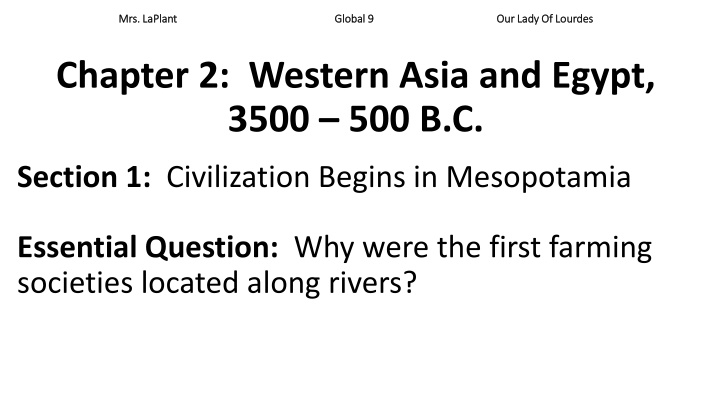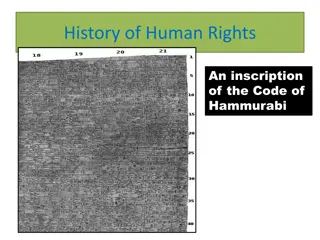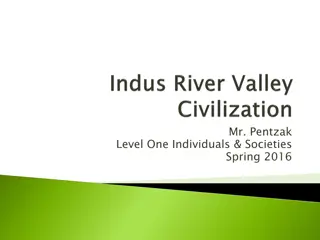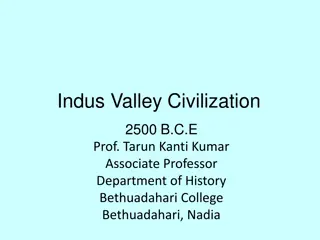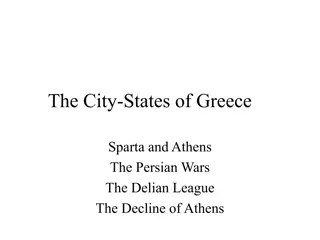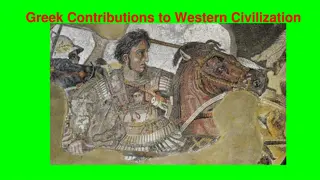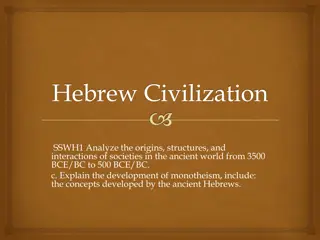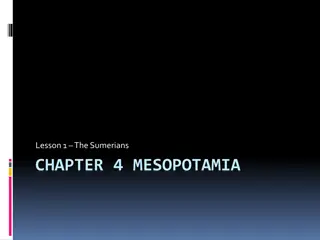Early Civilization in Mesopotamia: Sumerian Contributions and City-States
The early civilization in Mesopotamia, particularly the Sumerians, thrived along rivers due to fertile soil from floods and the ease of irrigation. Belief in multiple gods stemmed from harsh climates. Sumerian contributions spanned political, cultural, and technological realms. City-states played a pivotal role in governance, expanding their control and fortifying their cities with protective walls around temples dedicated to major deities.
Download Presentation

Please find below an Image/Link to download the presentation.
The content on the website is provided AS IS for your information and personal use only. It may not be sold, licensed, or shared on other websites without obtaining consent from the author.If you encounter any issues during the download, it is possible that the publisher has removed the file from their server.
You are allowed to download the files provided on this website for personal or commercial use, subject to the condition that they are used lawfully. All files are the property of their respective owners.
The content on the website is provided AS IS for your information and personal use only. It may not be sold, licensed, or shared on other websites without obtaining consent from the author.
E N D
Presentation Transcript
Mrs. LaPlant Mrs. LaPlant Global 9 Global 9 Our Lady Of Lourdes Our Lady Of Lourdes Chapter 2: Western Asia and Egypt, 3500 500 B.C. Section 1: Civilization Begins in Mesopotamia Essential Question: Why were the first farming societies located along rivers?
Why were the first farming societies located along rivers? The rivers flooded, leaving fertile soil. Irrigation systems could be built using the river s water, allowing seasonal growth of crops. River provided transportation
What caused the Mesopotamians to believe that supernatural forces (gods and goddesses) controlled their world? The climate was harsh and there were frequent famines (times of starvation). The belief that many gods and goddesses influenced all aspects of the universe, is a polytheistic religion.
Sumerian contributions to civilization: POLITICAL LIFE CULTURAL LIFE INVENTIONS
Sumerian contributions to civilization: POLITICAL LIFE CULTURAL LIFE INVENTIONS organized government religion writing law code architecture wagon wheel literature arch bronze sundial number system
How were city-states important in the development of government in Mesopotamia? City-states were the basic units of Sumerian civilization. They expanded and gained control over the surrounding countryside.
Why did Sumerians build walls around their cities? Walls gave them protection from attacks by other city-states or nomadic groups.
Why were the temples the most important buildings in the Sumerian city-states? The temples were dedicated to the chief god or goddess of the city. The temple was often built on top of a ziggurat.
What was the primary occupation of 90% of Sumerians? Farmers Why were the scribes different from the rest of the population, and why did they receive important government positions? The scribes were from the wealthy class and the only ones who knew how to read and write cuneiform, so they were important to the government.
The Standard of Ur The Standard of Ur War War p. 31 p. 31 What events are depicted in these panels? What does the War panel reveal about Sumerian society?
The Standard of Ur The Standard of Ur - - War War 'War' shows one of the earliest representations of a Sumerian army. Chariots, each pulled by four donkeys, trample enemies; infantry with cloaks carry spears; enemy soldiers are killed with axes, others are paraded naked and presented to the king who holds a spear.
The 'Peace' panel depicts animals, fish and other goods brought in procession to a banquet. Seated figures, wearing woolen fleeces or fringed skirts, drink to the accompaniment of a musician playing a lyre.
Hammurabis code Hammurabi s code Hammurabi s code is the oldest set of laws known to exist. Hammurabi was the king and chief priest of Babylonia from 1792-1750 B.C. He greatly expanded his empire, then he focused his energies toward wealth and justice for his people. He created a code protecting all classes of Babylonian society, including women and slaves.
He sought protection of the weak from the powerful and the poor from the rich. The carving on the stone on which the code is written depicts Hammurabi receiving the divine laws from the sun god, the god most often associated with justice. Hammurabi s Code contains 282 laws (possibly more have been rubbed off) that probably amend common Babylonian law rather than define it. It describes regulations for legal procedure, fixes rates on services performed in most branches of commerce and describes property rights, personal injury, and penalties for false testimony and accusations. It has no laws regarding religion.
Hammurabis code Hammurabi s code The Code of Hammurabi allowed men, women, slaves, and all others to read and understand the laws that governed their lives in Babylon. The Code is particularly just for its time. Although it follows the practice of "an eye for an eye", it does not allow for vigilante justice, but rather demands a trial by judges. It glorifies acts of peace and justice done during Hammurabi s rule. It symbolizes not only the emergence of justice in the minds of men, but also man s rise above ignorance and barbarism toward the peaceful and just societies still pursued today.
